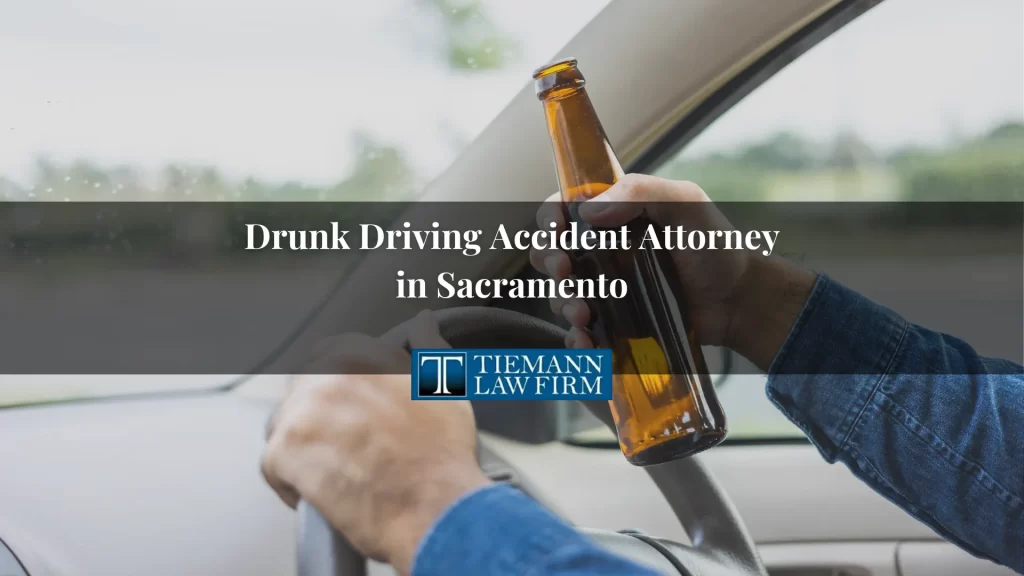
The message couldn’t be clearer: drunk driving kills. Yet, every day in the United States, almost 30 people are killed in drunk driving collisions, according to data from the National Highway Traffic Safety Administration. In 2018, the state of California had a total of 1,069 alcohol-impaired driving fatalities, while countless others are left hurt and suffering the consequences of someone else’s thoughtless and reckless actions.
At Tiemann Law Firm, we help victims involved in drunk driving accidents hold negligent drivers accountable for their actions. We also give victims valuable legal advice on the best ways we can help them pursue compensation following a serious drunk driving accident. You shouldn’t be left to foot the bill when a drunk driver lands you in the hospital. For information on how an experienced Northern California car accident attorney can help you recover the money you deserve, call Tiemann Law Firm at (916) 999-9000 today.
Basics of Drunk Driving in California
Every state has different laws and sometimes different thresholds for what constitutes drunk driving. In the state of California, a person is considered to be driving under the influence when their blood alcohol concentration reaches .08 percent or more. A person may also be considered under the influence if they appear to be substantially impacted by drugs, alcohol, or both. These intoxicated driving standards are even stiffer for commercial drivers, who can be considered under the influence if their BAC is .04 percent or higher. California also has a zero-tolerance law on the books, which makes it illegal for anyone under the age of 21 to get behind the wheel with a BAC as little as .01 percent.
Some drivers think that they can avoid being charged with a DUI offense by refusing to be tested for the presence of alcohol. That is a strategy that does not work in the state of California. California is an implied consent state, which means that the law requires that all drivers lawfully arrested for driving under the influence submit to some form of BAC testing. Any individual who refuses to submit to a test will be fined $125 and may have their license suspended.
Types of Drunk Driving Cases
Drunk driving is illegal and can carry severe penalties for those who choose to put their lives and the lives of others at risk by getting behind the wheel. When it comes to drunk driving, there are typically two different and distinct types of legal cases that may arise as a result of a serious crash.
The first case may be a criminal trial that results in criminal penalties or punishment. Most DUI charges in the state of California are misdemeanors and the penalties a driver may face can range from jail time, fines, or the suspension of their driver’s license, or sometimes a combination of all three.
However, when the driver is involved in an accident that causes a serious injury to another person, a death, or the driver has three or more prior DUI convictions, these aggravating factors can result in felony charges. The penalties for felony charges are much more severe and may include prison time, fines, and the suspension of the driver’s license.
The second type of legal case that a drunk driver may face is known as a civil case. A civil case is not about punishing the alleged wrongdoer; it is more about protecting another individuals’ rights and compensating them for damages caused by the accused individual. Compensation may include money for medical bills, loss of income, and pain and suffering or emotional distress.
In extreme situations, a court may pursue punitive damages. Punitive damages are a form of financial punishment that is meant to deter an individual from engaging in the same behavior that got them in trouble in the first place. A civil case is one option that victims of drunk driving accidents may pursue with the help of a skilled and experienced attorney.
Injuries Related to Drunk Driving Accidents
Injuries related to drunk driving accidents tend to be extremely serious. Medical studies have highlighted the serious impact that even a few drinks can have on the human body, including vision problems, loss of judgment, and altered mood. By the time an individual drinks enough to reach a BAC of .08 percent, the legal limit, they have a significantly reduced ability to concentrate, short-term memory loss, impaired judgment and perception, a lack of self-control, and slower response times both mentally and physically.
These impairments mean that a drunk driver may not only be unable to perceive a dangerous situation but by the time they do perceive it, they can be physically unable to avoid it. That means, unfortunately, accidents with drunk drivers tend to be at higher speeds and cause more significant injuries to victims. Some of the most common injuries that occur in drunk driving crashes tend to include:
- Traumatic brain injury
- Concussion
- Paralysis
- Other head, neck, and spine trauma
- Amputation
- Facial injuries
- Fractured Bones
- Organ damage
- Internal bleeding
- Road rash
- Burns
- Wrongful death
These types of injuries can impact a victim for years to come, sometimes even dramatically changing a victim’s quality of life. The medical costs associated with treating these types of injuries can be astronomical and cause significant financial stress and hardship to victims.
Common Accidents Associated with Drunk Driving
Due to the impairment, both physical and mental, of a drunk driver, intoxicated drivers tend to be more prone to causing certain types of accidents. Unfortunately, the types of accidents that are most common for drunk drivers also happen to be some of the most catastrophic and deadly types of crashes. These most common accidents associated with drunk driving include:
- Head-on collisions: Visual impairments and changes in judgment mean that drunk drivers can easily miss seeing or reading traffic signs and signals. They may turn the wrong way on a one-way street or veer into an oncoming lane of traffic, resulting in a head-on collision. These collisions, especially at high rates of speed, are traumatic and often deadly because all the energy of the crash is focused on the front of the vehicle, right where the driver is sitting.
- Wrong-way collisions: Being unable to clearly read posted traffic signs or signals often leads to wrong-way collisions. An impaired driver may not realize that they are entering into an off-ramp or are getting onto a highway going the wrong direction. Wrong-way crashes often turn into head-on crashes, causing serious damage and injuries.
- Rear-end collisions: Drunk drivers don’t have their full attention to give to the road ahead and their surroundings. Drunk drivers also experience a significant slowdown in their reaction time and reflexes. Not being aware of their surroundings and then being unable to respond quickly enough to a change in driving circumstances means that rear-end accidents are a serious consequence of driving while intoxicated.
- Pedestrian/Bicycle Accidents: Many drunk driving accidents happen at night. Intoxication is known to impact vision and that, combined with darkness, makes it extremely hard for drunk drivers to see pedestrians and bicyclists. Pedestrians hit by drunk drivers are at a higher risk of suffering traumatic and fatal injuries.
Compensation Following a Drunk Driving Accident
 Victims involved in drunk driving collisions may be able to pursue compensation through a variety of legal means. The first is a civil suit against the alleged drunk driver. This avenue involves taking the driver to court to get a judgment for compensation. A civil case differs from a criminal case in that the burden of proof is on the plaintiff to demonstrate that the defendant is more likely than not to have caused the accident. The victim, or defendant, in a civil suit may pursue compensation for both economic and non-economic damages.
Victims involved in drunk driving collisions may be able to pursue compensation through a variety of legal means. The first is a civil suit against the alleged drunk driver. This avenue involves taking the driver to court to get a judgment for compensation. A civil case differs from a criminal case in that the burden of proof is on the plaintiff to demonstrate that the defendant is more likely than not to have caused the accident. The victim, or defendant, in a civil suit may pursue compensation for both economic and non-economic damages.
Economic damages are measurable losses suffered as a result of an accident. These losses may include medical costs, lost income, loss of earning capacity, and property damage. Non-economic damages are more subjective and deal with emotional distress and quality of life issues that may arise following the accident.
Examples of non-economic damages can include disfigurement, emotional distress, loss of companionship, and pain and suffering. In certain cases, punitive damages may also be awarded. Punitive damages do not cover the cost of any specific bill or trauma. They are meant to be a financial punishment for the perpetrator, deterring them from engaging in negligent or reckless behavior in the future.
A victim may also be able to pursue damages from the other driver. California is known as a “fault” state when it comes to car accidents and liability. That means that following an accident, a victim can file a claim with the at-fault driver’s insurance company seeking compensation, whereas in a no-fault state, a victim would have to file a claim with their own insurance company.
Going through the other driver’s insurance company is one of the most common ways of attempting to recover compensation after a serious accident. Many drivers feel that this option is simple and does not require outside help to resolve. However, having a skilled attorney on your side means you have an aggressive and experienced negotiator who can help you seek full and fair compensation after an accident.
Contact an Experienced Northern California Drunk Driving Accident Attorney Immediately
You chose to drive safely and follow the rules. Another driver chose to break the law and drive intoxicated. You are already suffering the painful consequences of their reckless actions; should you also be forced to pay financially for their choice as well? At Tiemann Law Firm, we don’t think so. We believe you deserve aggressive representation and the maximum amount of compensation you are entitled to.
After an accident with a drunk driver, call the law offices of Tiemann Law Firm for valuable information on your legal options for recovering compensation. We can review your case and lay out which options may be right for you. Contact us today to set up your free consultation. Call (916) 999-9000 and talk to an experienced Northern California car accident attorney.


